Prehistory of the Andean Peoples
© 1998 by James Q. Jacobs
Several times during Andean prehistory
people coalesced into large political entities. It is therefore possible
to consider an Andean civilization and tradition. One indicator of this
social and political unity is Quechua, presently spoken by some 10 million
people from Ecuador to Argentina, a distance of thousands of miles.
Quechua refers to the mountain zone between 3,000 and 11,000 feet in
the Andes of South America. Only in historic times has the term been
applied to Runa Simi, the language of the Inca civilization.
Most of the descendants of the Indians of the Incan realm are the present-day
Aymara and Quechua speaking peoples of the Andes. Quechua speakers constitute
almost half the population of Perú. Aymara and Quechua traditions
are very similar and were unified under the Incas and possibly under
previous political centers, particularly Tiwanaku.
PREHISTORY OF THE ANDEAN PEOPLES
The Andean region produced a unique emergence of civilizations
at an early date. A pre-agrarian, pre-ceramic adaptation to rich, easily
accessible maritime resources coupled with a vertical adaptation to
nearby stacked mountain resource zones enabled very early sedentary
communities to develop along the Pacific coast. Populations grew to
1,000 to 3,000 person villages and large monumental
architecture developed. Contemporaneous to the construction of pyramids
in Egypt and ziggurats in Mesopotamia, Peruvian coastal communities
cyclically renovated ever larger pyramidal platform mounds. Aspero,
a large early center with platform mounds, has 4800 to 5000 BP. carbon
14 dates from late phase construction.
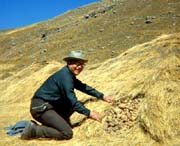 Cultigens are first known in South America from 10,000
BP. Coastal agriculture included introduced cultigens from both the
highland and Amazon zones. A two hundred kilometer transect of the Andes
includes twenty of the world's thirty four life zones in a transition
from extreme aridity to extreme altitude and then extreme humidity and
rainfall. Interaction, exchange and multiple zone exploitation of this
diverse region was facilitated by the beast of burden adaptation of
the llama. During the Pre-ceramic Period (5000 - 4000 BP.) cultivated
squash and tubers introduced from the highlands, tropical tubers, beans
and peppers from the Amazon and a variety of local wild grasses, seeds
and fruits were exploited. By 4,000 BP. irrigation agriculture appeared
in coastal valleys. Cultigens are first known in South America from 10,000
BP. Coastal agriculture included introduced cultigens from both the
highland and Amazon zones. A two hundred kilometer transect of the Andes
includes twenty of the world's thirty four life zones in a transition
from extreme aridity to extreme altitude and then extreme humidity and
rainfall. Interaction, exchange and multiple zone exploitation of this
diverse region was facilitated by the beast of burden adaptation of
the llama. During the Pre-ceramic Period (5000 - 4000 BP.) cultivated
squash and tubers introduced from the highlands, tropical tubers, beans
and peppers from the Amazon and a variety of local wild grasses, seeds
and fruits were exploited. By 4,000 BP. irrigation agriculture appeared
in coastal valleys.
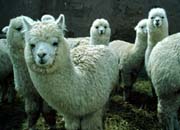 Coastal-Andean interaction spheres are especially evidenced
during the 4000 - 2800 BP. Initial Period, when more mound building occurred
than during any other period. Initial Period centers share a characteristic
U-shaped site layout and mountain facing orientation. Sechin Alto grew
to be the largest. In 3400 BP. Sechin Alto's 300 m. by 250 m. by 40 m.
high colossal, stone-faced mound was the largest American monument. Coastal-Andean interaction spheres are especially evidenced
during the 4000 - 2800 BP. Initial Period, when more mound building occurred
than during any other period. Initial Period centers share a characteristic
U-shaped site layout and mountain facing orientation. Sechin Alto grew
to be the largest. In 3400 BP. Sechin Alto's 300 m. by 250 m. by 40 m.
high colossal, stone-faced mound was the largest American monument.
Chavín de Huantar is
erroneously viewed as the first South American civilization horizon and
coincides with the Early Horizon (2800-2200 BP.). Chavín, located
on a principal pass from coast to jungle, is a monumental site with finely
carved stone sculpture with elaborate iconography and art. The homogeneous
Chavín style followed a diverse heterogeneous pattern in Initial
Period ceramics. At Chavín the monumental architecture includes
a U-shaped principal mound oriented to face the rising sun. Deep within
the platform mound a cruciform chamber is centered on El Lanzón,
a thirteen foot tall, prism-shaped stela that extends from floor to
ceiling. Carved in bas-relief, the stela depiction includes a standing
anthropomorph that combines feline characteristics and serpent depiction.
Around 2250 BP., military architecture appears, coincidental to an
apparent disruption of regional integration.
A second significant South American center emerged in
the southern uplands at Tiwanaku on Lake
Titicaca. The immense lake's 12,600 feet above sea level shoreline supported
a dense population. The Tiwanaku survival strategy augmented the Andean
agropastoral adaptation with a combined raised-bed and shoreline canal
agriculture system. The water temperature in the canals mediated frosts,
effectively extending the short, high-elevation growing season and increasing
yields.
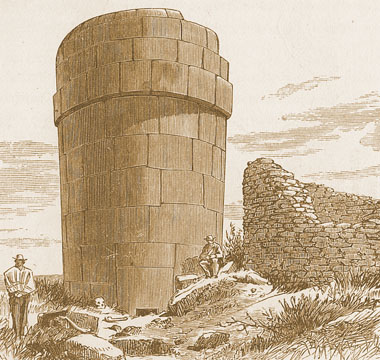
Tiwanaku culture became the largest Andean regional
integration and enjoyed an unprecedented longevity of 1400 years. The
Tiwanaku polity covered large portions of Bolivia, Argentina, Chilé,
and Perú. At Tiwanaku one of the great Andean platform complexes
and one of the highest urban centers ever, was built around 2400 BP.
It grew to house from 25,000 to 40,000 people.
Tiwanaku's central monument precinct covers twenty hectares
and is laid out on a cardinal direction oriented grid. The enormous
Akapana mound is 200 meters long per side and stands 15 meters tall.
Its andesite facing was quarried at 100 kilometers distance. Many of
the major buildings date from the Early Intermediate period (AD 200-600).
During the Middle Horizon (AD 600-1000) Tiwanaku influences are seen
throughout the central and southern Andes. Tiwanaku declined around
1000 BP. Abandonment of the raised bed-canal agriculture system, due
to a natural lowering of the Altiplano's rainfall and the consequent
lowering of the basin's great lake may have contributed to the decline
of the great city.

Moche civilization became a regional integration of
part of the northern Andes contemporaneous with Tiwanaku. The Moche
constructed the largest Andean adobe structure, the Huaca del Sol, one
of the two or three largest South American monuments. The Moche were
followed by the Chimor. They consolidated 1000 km of coast under the
second largest prehistoric polity in South America. Numerous other regional
polities have played a role in the development of Andean civilization.
Local hegemonies, some coastal, some montane and still others bridging
geographic barriers, had risen, expanded, and collapsed prior to the
Incan regional unification.
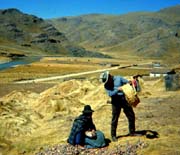 The greatest of all central polities of the Andes, the
Incan civilization, unified the Andes a mere century before European
intrusion. The Inca state was called Tahuantinsuyu, the 'Land of the
Four Quarters,' and was centered on Cuzco, Perú. Inca was a title
bestowed on the political leader and referred to the ruling ayllu (kinship
group). Today Inca refers both to the people and the polity. The first
Inca, Manco Capac, was revered as a civilizing hero. According to Garcilaso
de la Vega's version of Andean history, Manco Capac came from the Lake
Titicaca region. Felipe Gauman Poma de Ayala wrote that the first Incas
came from Lake Titicaca and Tiwanaku, lived in Tambotoco (also called
Pacaritambo) and four brothers and four sisters left to found Cuzco.
These included Manco Capac and his wife. The greatest of all central polities of the Andes, the
Incan civilization, unified the Andes a mere century before European
intrusion. The Inca state was called Tahuantinsuyu, the 'Land of the
Four Quarters,' and was centered on Cuzco, Perú. Inca was a title
bestowed on the political leader and referred to the ruling ayllu (kinship
group). Today Inca refers both to the people and the polity. The first
Inca, Manco Capac, was revered as a civilizing hero. According to Garcilaso
de la Vega's version of Andean history, Manco Capac came from the Lake
Titicaca region. Felipe Gauman Poma de Ayala wrote that the first Incas
came from Lake Titicaca and Tiwanaku, lived in Tambotoco (also called
Pacaritambo) and four brothers and four sisters left to found Cuzco.
These included Manco Capac and his wife.
Pachacuti Inca Yupanqui, the ninth Inca, is considered
the greatest Inca. Around 1438 Pachacuti replaced his brother Inca Urcon
after overcoming the Chanca invasion. Pachacuti consolidated a large
polity, a territory spanning from the Titicaca Basin to central Perú.
Pachacuti is credited with the construction of many monumental sites
and with instituting wise laws. He reconstructed Cuzco, built the Coricancha,
the so-called "Temple of the Sun," and initiated construction of Saxsayhuaman.
Saxsayhuaman's polygonal masonry terraces include many immense stones.
The largest, a twenty-eight feet tall stone has been liberally estimated
to weigh over 360 metric tons (conservatively at 120), one of the largest
stone blocks ever incorporated in a structure.
In 1471 Pachacuti was succeeded by his son Topa Yupanqui.
Topa Yupanqui added Ecuador and northern Perú to Tahuantinsuyu.
In a few generations the Incas consolidated under one government the
Andean region from the border of Colombia to the Rio Maule in Chilé,
nearly 400,000 square miles, potentially the largest nation on the earth
at the time. This area twice the size of Spain encompassed at least
12,000,000 people who spoke more than 20 languages. More than 100 independent
ethnic groups had been consolidated into the Tahuantinsuyu state. Two
great north-south roads, one running along the coast for about 3,600
km, the other inland along the spine of the Andes spanning a comparable
distance, and many interconnecting links helped unify the realm. The
30,000 to 40,000 km of major roadways was one of the best in the world.
A system of runners facilitated communications.

Most of the pre-Colombian population lived above 10,000
feet. The prehistoric economy was based on agriculture, its staples
being corn (maize), potatoes and sweet
potatoes, squash, tomatoes, peanuts (groundnuts), chili peppers, coca,
cassava, and cotton. Some forty domesticated plants were cultivated.
About 700 variety of potatoes are known. They raised guinea pigs, ducks,
llamas, alpacas, and dogs. Alpacas
and llamas were domesticated for their fleece. Llamas, the only beast
of burden in all the Americas, served as pack animals. Clothing was
made of llama, alpaca and vicuña
hair and cotton. Houses were of stone or adobe mud. Practically everyone
was a farmer, producing his/her own food and clothing. Communities took
advantage of the mountain environment by utilizing various elevations
and climates. Alpacas grazed the highest terrain where crops could not
survive.
The Andean peoples are traditionally organized in ayllus,
common descent family groups owning land in community. Animals were
grazed on common pastures. Land use was from time to time redistributed
according to family needs. Irrigation systems supported agriculture
where cultivation was otherwise impossible. Terracing converted steep
mountains into fertile flat fields. One of the greatest engineering
feats of humanity in its time was a river diversions in ancient coastal
Perú. Guano from coastal islands was used as fertilizer and guano
producing birds were protected by law. The specialized Andean adaptations
were highly successful and their cultigens have greatly benefited the
modern world.
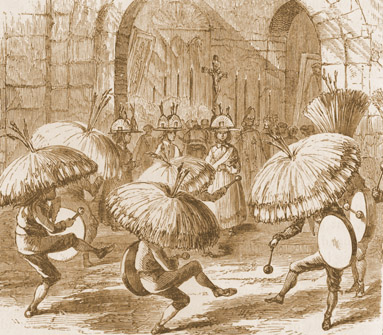
Before the Spaniards arrived in the Andes smallpox and
other infectious diseases of European origin swept across the Americas.
Two-thirds or more of the population perished before contact, making
conquest all the easier. Topa Yupanqui's successor, Huayno Capac, died
of European diseases a few years before Francisco Pizarro's conquering
band of Spaniards killed his son, Inca Atahualpa. The conquerors first
held Atahualpa for ransom. They received a 20 by 18 feet room filled
to the ceiling with gold in exchange for the Inca's life before killing
him. So began the Historic Period in the Andes.

See Bibliography page
for citations.
Other Andes academic papers:
TUPAC
AMARU, THE
LIFE, TIMES, AND EXECUTION OF
THE LAST INCA
EARLY
MONUMENTAL ARCHITECTURE OF THE PERUVIAN COAST
CHAVIN
AND THE ORIGINS OF ANDEAN CIVILIZATION
|